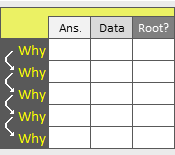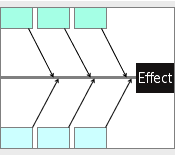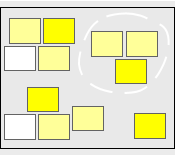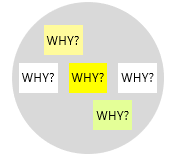
Also known as Five Whys.
Variants include Therefore Test and So What Test.
The 5 Whys technique is widely recognized as a valuable approach for problem-solving and root cause analysis. It is also one of the simplest techniques and easiest to put into practice. It is used in everyday business situations to identify the possible causes underlying a specific problem. Originally introduced and popularized by Toyota through their Toyota Production System, it has gained widespread adoption within Lean and Six Sigma frameworks.
The 5 Whys technique serves as a cause-and-effect analysis tool, enabling the identification of potential sources of process variation. Yet, it is so simple that can be implemented without collecting data and without the need for advanced statistical techniques. By repeatedly asking the question, “Why does this happen?” in relation to a problem, waste, or defect, valuable insights can be uncovered. Each answer obtained forms the basis for the subsequent question in the analysis.
By asking “Why” multiple times, a deeper understanding of the problem can be obtained, ultimately revealing the underlying root cause. This approach adds depth to the problem-solving process and encourages a comprehensive examination that goes beyond surface-level symptoms and assumptions. Once the true root cause is identified, the chance for an effective solution significantly improves.
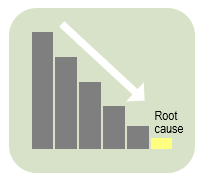
The following is a commonly referenced example to explain the 5 Whys technique:
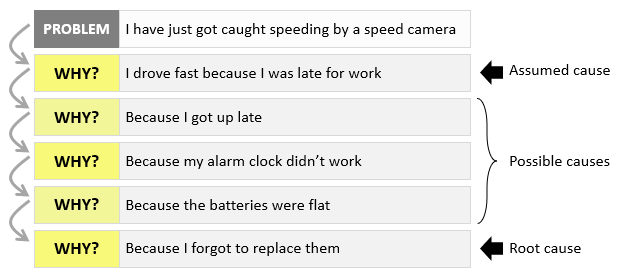
Typically, the practice of asking “Why” five times consecutively is generally enough to get you quite close to the root cause of a problem. Five seems to be is a good starting point, however, you may find that you need to ask “Why” more or less times depending on the situation. The objective is to get to a place where you can address the core of the problem. The key to identifying the root cause is to keep looking and you will eventually get to the true cause which you can act on right away.
Once the cause of a problem has been determined, it is important to implement corrective actions for resolution. Remember that each answer obtained through the “Why” questioning serves as a hypothesis that can be validated through process testing. Validating the truth of every answer helps in discovering the true root cause, or at least, ensures that you are supporting your answers with evidence and data.

5 Whys can be applied individually or as part of a comprehensive cause-and-effect analysis. Its effectiveness can be enhanced by combining it with other methods such as fishbone analysis, brainstorming and root cause analysis. Sometimes, you may have more than one factor that contributes to the problem. Other times, the problem is too complex to be analyzed in a straightforward manner.
When multiple factors contribute to a single problem, a fishbone diagram can assist in identifying and organizing all potential causes. Once all possible causes are identified on the fishbone diagram, the 5 Whys approach can be employed to drill down to the root causes for each possible cause. However, it is important to note that the 5 Whys technique is best suited for simple problems with limited or even one possible root cause. Complex problems often need more advanced analysis techniques.

The 5 Whys technique can be employed both in a team setting or individually. When it is undertaken as a collaborative exercise, team members should have a clear understanding of the problem at hand. It can be more effective when the participants consist of front-end operators and Subject Matter Experts, which enhances the effectiveness of the process. It is advisable to involve individuals experienced in the relevant processes and seek assistance when necessary.
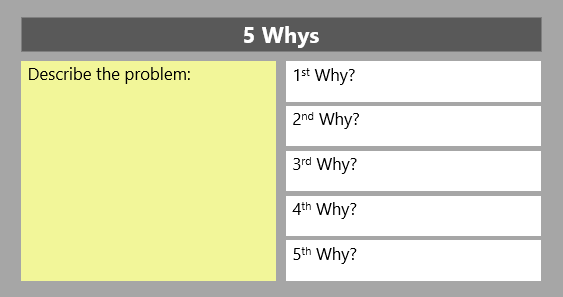
Using the 5 Whys Approach
- With your team, write a clear and specific problem statement. Ensure your problem is relevant and solving it will make a difference.
- Ask “Why the problem occurs?”. Write the answer down below the problem.
- Ask Why again for the generated answer and write the answer down.
- Keep asking Why until the team identify the root cause of the problem, or until you get the answer “I don’t know”.
- Once you are finished, discuss and agree on the corrective actions that will permanently correct the problem.
Note: Avoid vague or broad answers even though they may be true. Answers must be specific enough to help solve the problem.
Example – Delayed Test Results
In this particular case, a team effectively employed the 5 Whys approach to uncover the reason behind a customer complaint regarding the delayed test results at a laboratory.

Notice in this example that only four Whys were required to get to what looks to be the root cause.
Example – Maintenance Department
Here’s another example that demonstrates the use of the 5 Whys approach to address a concern raised during a Lean Six Sigma workshop.
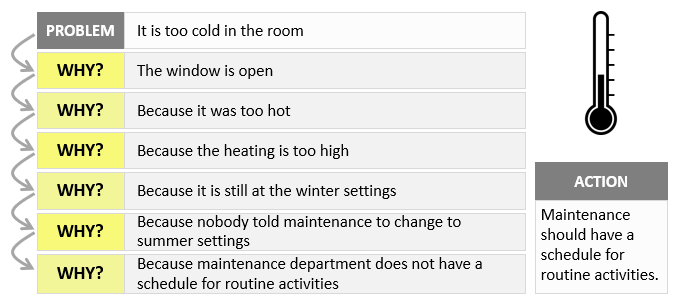
Note that you can carry on asking Why and ask, “why doesn’t maintenance department have a schedule for routine activities?”. This will get you to a deeper level where you need to improve the business process in order to solve the problem.
Source: Smallpeice Enterprises (www.smallpeice.co.uk)

There are numerous tools available to assist in the application of the 5 Whys technique for problem analysis. One of the most straightforward approaches involves utilizing this 5 Whys Template.
Wrapping Up
In conclusion, the 5 Whys technique is a simple yet powerful approach for problem-solving and root cause analysis within Lean and Six Sigma frameworks. By repeatedly asking “Why” in response to a problem, it reveals valuable insights and ultimately uncovers the underlying root cause. In complex scenarios, more advanced analysis methods may be necessary. After identifying the cause, corrective actions need to be taken to permanently correct the problem.
Other Formats
Do you want to use the slides in your training courses?

5 Whys Training Material – $18.85
Related Articles
Related Templates






